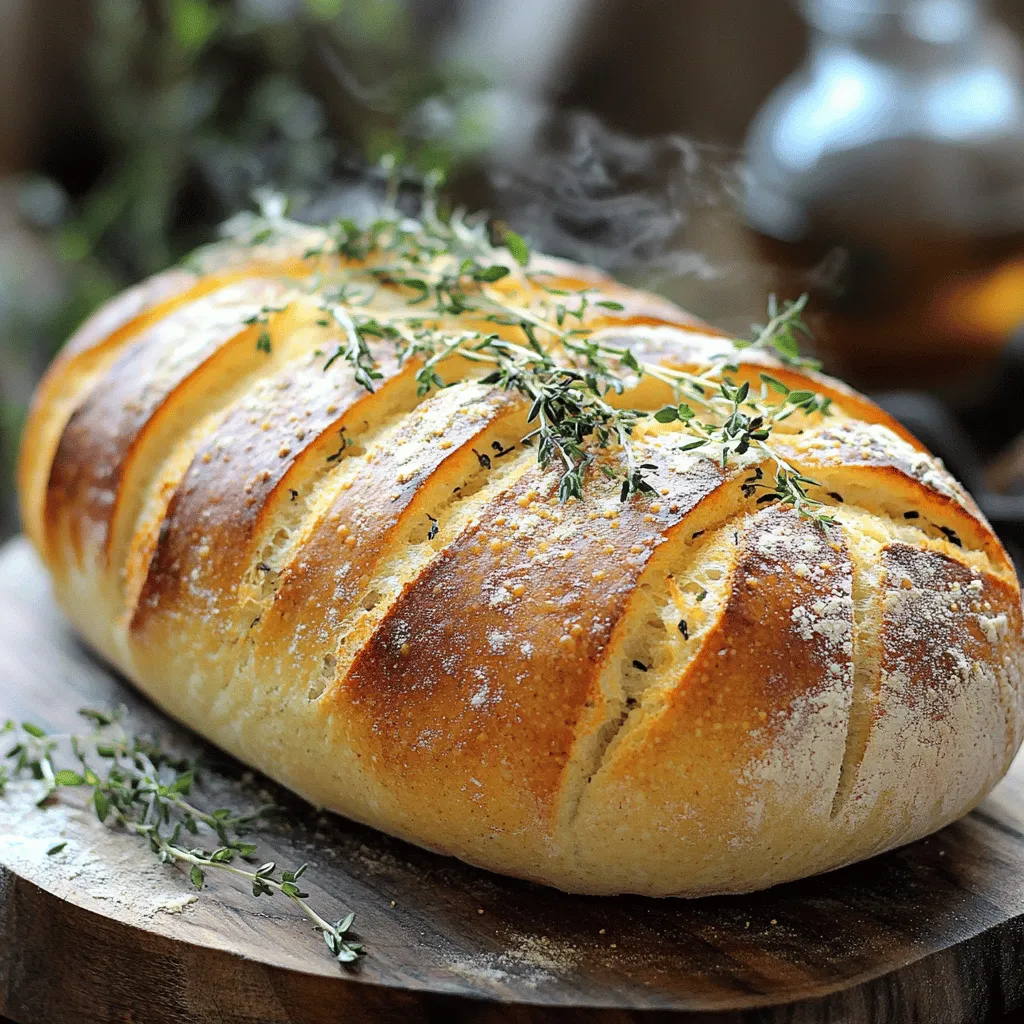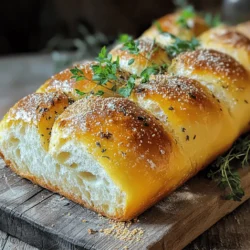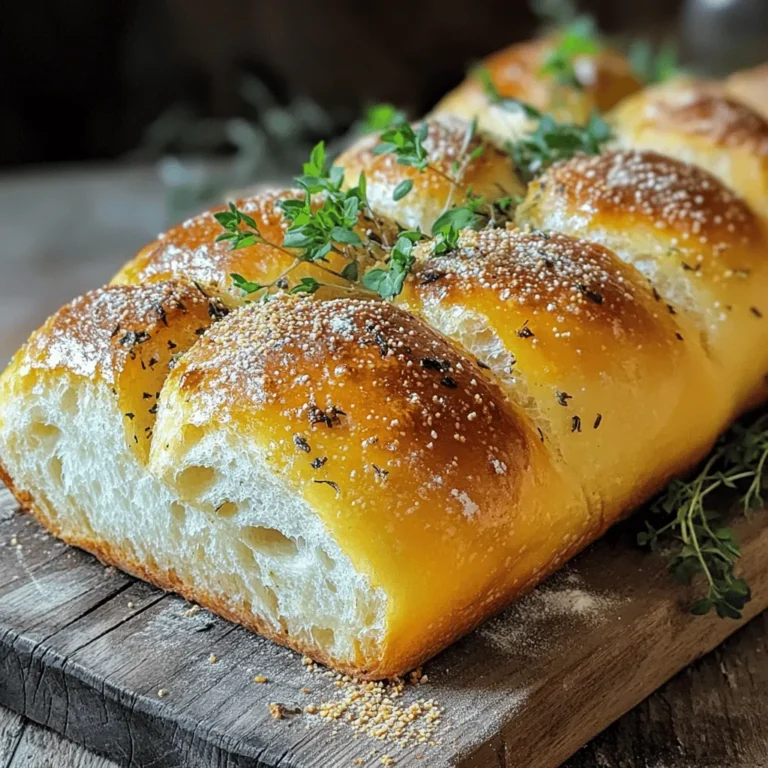Are you ready to bake a loaf that will wow your family and friends? This Savory Herb Crusty Bread recipe is simple, fun, and downright tasty! With just a handful of ingredients and easy steps, you’ll have warm, crusty bread filled with aromatic herbs. Perfect for dipping or as a side, this bread is a must-try! Let’s dive into the details and make your kitchen smell amazing!
Ingredients
List of Ingredients
- 4 cups all-purpose flour
- 2 teaspoons salt
- 1 teaspoon sugar
- 2 teaspoons instant dry yeast
- 1 ½ cups warm water (about 110°F)
- 2 tablespoons olive oil
- 1 tablespoon dried oregano
- 1 tablespoon dried thyme
- 1 tablespoon garlic powder
- 1 tablespoon rosemary, finely chopped (fresh or dried)
- Cornmeal (for dusting)
To make savory herb crusty bread, gather these simple ingredients first. The flour gives the bread its structure. Salt adds flavor and helps control yeast activity. Sugar feeds the yeast for a good rise. The instant dry yeast makes the dough rise quickly. Warm water activates the yeast for the best results.
Olive oil adds moisture and flavor to the dough. Using dried herbs like oregano and thyme gives the bread its savory note. Garlic powder adds a punch of flavor, and rosemary gives it a lovely aroma. Lastly, cornmeal dusts the baking surface to prevent sticking and adds a nice texture.
Make sure you have everything ready before you start. This will help the process go smoothly.
Step-by-Step Instructions
Preparation of Ingredients
- Combine Dry Ingredients: In a large bowl, add 4 cups of all-purpose flour, 2 teaspoons of salt, 1 teaspoon of sugar, 2 teaspoons of instant dry yeast, 1 tablespoon of dried oregano, 1 tablespoon of dried thyme, 1 tablespoon of garlic powder, and 1 tablespoon of rosemary. Mix them well. This helps the flavors to blend.
- Mix Wet Ingredients: Next, create a well in the center of your dry mix. Pour in 1 ½ cups of warm water and 2 tablespoons of olive oil. Use a wooden spoon to mix. Keep stirring until the dough looks shaggy.
- Kneading the Dough: Once the dough forms, move it to a floured surface. Knead it for about 10 minutes. You want it to be smooth and elastic. If it feels sticky, sprinkle a bit more flour. This step develops the gluten.
First Rise
- Placing in the Bowl: After kneading, place the dough in a greased bowl. Make sure the bowl is large enough. The dough needs room to grow.
- Covering the Dough: Cover the bowl with a damp cloth. This keeps the moisture in. It helps the dough rise.
- Ideal Rising Conditions: Let the dough rise in a warm place for 1 to 1.5 hours. It should double in size. A warm kitchen or near a sunny window works well.
Shaping and Second Rise
- Punching Down the Dough: After the first rise, gently punch the dough. This releases air bubbles. It helps to create a better texture.
- Shaping Techniques: Shape the dough into a round ball or an oblong loaf. Your choice depends on how you like your bread. This step helps give it form.
- Preparing for the Oven: Place the shaped dough on a cornmeal-dusted baking sheet. Cover it loosely again with the damp cloth. Let it rise for another 30-45 minutes. This second rise adds more flavor.
Baking Process
- Preheating the Oven: Preheat your oven to 450°F (232°C). This high heat gives the bread a crusty finish.
- Making Slashes on the Dough: Once the dough has risen, use a sharp knife to make a few shallow slashes on top. This allows steam to escape.
- Adding Steam for a Crusty Texture: For a crusty exterior, place an oven-safe dish of water in the oven. The steam helps the bread bake evenly.
- Baking Time: Bake the bread for about 25-30 minutes. It should be golden brown and sound hollow when tapped on the bottom.Enjoy the process and the delightful smells as the bread bakes!
Tips & Tricks
Perfecting the Crust
Oven Temperature Tips
To get a great crust, set your oven to 450°F (232°C). This hot temperature helps the bread rise quickly and forms a nice crust. If your oven has a hot spot, rotate the bread halfway through baking. This ensures even cooking and browning.
Steam Creation Techniques
Steam is key for a crusty exterior. Place a small oven-safe dish filled with water in the oven while it preheats. The steam keeps the dough moist, allowing it to expand. You can also mist the oven with water using a spray bottle just before closing the door.
Enhancing Flavor
Suggested Herb Combinations
Mixing herbs can boost flavor. Rosemary, thyme, and oregano work well together. You might also try basil or dill for a twist. Experiment to find what you like best!
Using Fresh vs. Dried Herbs
Fresh herbs add a bright taste but can be harder to find. Dried herbs are easy to use and have a strong flavor. If you use fresh herbs, double the amount since their flavor is milder.
Troubleshooting Common Issues
Addressing Sticky Dough
If your dough is sticky, add a little more flour while kneading. Use just enough to make it manageable. Avoid adding too much flour, or the bread may become tough.
How to Identify Proper Doneness
Your bread is done when it looks golden brown. Tap the bottom; if it sounds hollow, it’s ready. Use an instant-read thermometer to check; the center should be about 190°F (88°C).

Variations
Herb Blends
You can change the herbs to create new flavors.
- Italian Herb Blend: Mix dried basil, parsley, and oregano. This blend gives your bread a classic Italian taste.
- Mediterranean Inspired Additions: Use herbs like dill and tarragon. These add a bright and fresh flavor to your bread.
Incorporating Other Ingredients
Adding extra ingredients can make your bread even tastier.
- Adding Cheese: Grate some Parmesan into the dough. It melts well and adds a rich flavor.
- Adding Vegetables: Chopped sun-dried tomatoes add a sweet and tangy kick. You can also try olives for a briny touch.
Gluten-Free Options
If you need a gluten-free version, you can still enjoy this bread.
- Suitable Gluten-Free Flours: Use a blend of almond flour and coconut flour. These create a nice texture without gluten.
- Adjustments Needed for Texture: Add more water and a binding agent like xanthan gum. This helps hold the bread together and improves the rise.
Storage Info
Short-term Storage
To keep your Savory Herb Crusty Bread fresh, wrap it well. You can use a bread bag or a cloth. Bread bags keep moisture in, while cloth lets it breathe. If you want a crusty texture, go with cloth. For a softer crust, use a bread bag.
Long-term Storage
If you want to save the bread for later, freezing is great. First, let the bread cool completely. Then, wrap it in plastic wrap and foil. This prevents freezer burn. You can freeze it for up to three months.
To thaw, take the bread out and unwrap it. Let it sit at room temperature for a few hours. You can also warm it in the oven for a few minutes to refresh the crust.
Shelf Life
How long does this bread last? When stored properly, it can last about three days at room temp. After that, it may get stale.
Signs of staleness include a hard crust and dry texture. If the bread smells off or shows mold, it’s time to toss it. Enjoy your Savory Herb Crusty Bread fresh for the best taste!
FAQs
How do I make Savory Herb Crusty Bread?
To make Savory Herb Crusty Bread, follow these steps:
1. Gather your ingredients: flour, salt, sugar, yeast, water, olive oil, and herbs.
2. Mix the dry ingredients in a large bowl.
3. Create a well in the mix, then add warm water and olive oil.
4. Stir until a dough forms.
5. Knead the dough on a floured surface for about 10 minutes.
6. Place the dough in a greased bowl and let it rise for 1 to 1.5 hours.
7. Once it doubles in size, punch it down and shape it.
8. Let it rise again for 30-45 minutes.
9. Preheat the oven to 450°F.
10. Bake for 25-30 minutes until golden brown and hollow when tapped.
This process leads to a crusty, herb-filled delight.
Can I use active dry yeast instead of instant dry yeast?
Yes, you can use active dry yeast. Just follow these guidelines:
- Use the same amount as instant yeast.
- Activate the active dry yeast first. Dissolve it in warm water with sugar. Let it sit until bubbly.
- Then, mix the activated yeast with your dry ingredients.
This method works well and gives great results.
Why did my crust not turn out crispy?
There are several factors that can affect your crust texture:
- Oven Temperature: Make sure your oven is hot enough. Preheat it well.
- Steam: Adding steam helps create a crispy crust. Place a dish of water in the oven while baking.
- Baking Time: Underbaking can lead to a softer crust. Ensure it is golden brown and sounds hollow when tapped.
Adjust these factors to achieve that perfect crust.
What can I serve with savory herb crusty bread?
Savory herb crusty bread pairs well with many dips and spreads:
- Herbed Olive Oil: Mix olive oil with fresh herbs for dipping.
- Hummus: Creamy and flavorful, hummus complements the bread nicely.
- Cheese Spreads: Soft cheeses like goat cheese or cream cheese work great.
- Soups: Serve with your favorite soup for a hearty meal.
These options enhance your bread experience!
In this post, we covered how to make delicious savory herb crusty bread. Start with the right ingredients and follow each step carefully. I shared tips for perfecting your crust and enhancing flavor. Remember to try different variations that suit your taste. Store your bread properly for the best freshness. With these tools, you’ll enjoy fresh bread right from your oven. Embrace this fun process and share your tasty results!


